FAQs on African Cichlid Infectious Disease
(Virus, Bacterial, Fungal)
FAQs on African Cichlid Disease:
African Cichlid
Disease 1, African Cichlid Disease 2,
African Cichlid Disease 3,
African Cichlid Disease 4,
African Cichlid Disease 5,
African Cichlid Disease 6,
African Cichlid Disease 7,
African Cichlid Disease 8,
FAQs on African Cichlid Disease by Category:
Diagnosis,
Environmental,
Nutritional,
Social, Parasitic (Ich, Velvet...),
Genetic,
Treatments,
Related Articles: African Cichlids,
Malawian Cichlids: The Mbuna and their Allies By Neale Monks,
The Blue
Followers: the Placidochromis of Lake Malawi by Daniella
Rizzo, Cichlid Fishes,
Related FAQs: Cichlid Disease,
Cichlid Disease 2,
Cichlid Disease 3,
African Cichlids in General,
African Cichlid Identification,
African Cichlid Selection,
African Cichlid Behavior,
African Cichlid Compatibility,
African Cichlid Systems,
African Cichlid Feeding,
African Cichlid Reproduction,
Cichlids of the World,
Cichlid Systems,
Cichlid Identification,
Cichlid Behavior,
Cichlid Compatibility,
Cichlid Selection,
Cichlid Feeding,
Cichlid Disease,
Cichlid Reproduction,
|
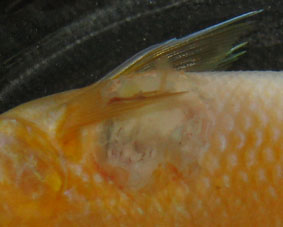
|
|
Please help me help my bumble bee
1/14/16
I've purchased my bumble bee cichlid from my avid fish loving brother a couple
of months ago. Along with a blood parrot and currently small green terror.
Bumblebee had these growths before i brought him home for quite some time,
although, nearly half this size.
<Apparently some sort of infection of the nares>
Not sure on age but he's around 5 inches long. I have been doing water changes
accordingly. His health is declining and in his weakened state he's being easily
chased into hiding from the blood parrot when in the beginning they all did well
together
with ample hiding places he seemed completely healthy aside from the unsightly
growths. I've noticed today he did not eat. Came out long enough for me to snap
this picture. Im worried. Im hoping its not a tumor but with it only seeming to
grow i am not sure what else this could possibly be.
<Likely some sort of infectious agent, proceeding from environmental stress....
"poor water quality" of some kind/s>
His color no longer seems to change mostly remains faint. I thought maybe the
growths could fall off but nothing in all this time. in the last week a bump has
formed in between the nostrils under the skin. Only looking worse. If there is
ANYTHING i can do to save him please please let me know.
<Well; if it were mine.... I'd likely euthanize this specimen (see WWM Re)...
but if you're willing to try.... I'd subject the entire system to a modicum of
"Malawi Salts" (see Neale Monk's works re on WWM); and trying a "Furan" drug
(Nitrofuranace my choice) here per SOP statements on WWM. Bob Fenner>
|
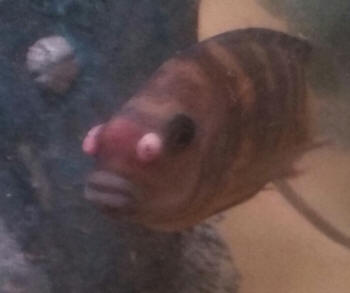 |
|
Intermedius cichlid... hlth.
8/9/15
Hello!
I'm writing to inquire about what appears to be a cluster of red lumps
on my intermedius cichlid's fin.
<Looks like Lymphocystis or some other viral infection.>
The fish is a few years old and has been living in my 125 gallon tank with about
20 tankmates. No one else is exhibiting anything similar. He is fine in regards
to eating and swimming normally. Aggression is minimal and water parameters
tested fine as far as nitrates, nitrites, Ph, etc.
<Please don't tell us "fine" but instead give us the numbers. To be clear:
most of these viral infections are triggered by environmental shortcomings.
Actually quite a body of research into this because wild fish with viral cysts
are potential indicators of environmental pollution. So something's amiss.
Either review yourself and act accordingly, or send us some numbers. To recap:
Malawian cichlids like Tramitichromis intermedius must have hard, alkaline water
(15+ degrees dH, pH 7.5-8.5). Ammonia and nitrite must be zero of course, but
nitrate must also be as low as practical, ideally below 20 mg/l. Water
temperature should be middling to warm (25-26 C/77-79 F is fine) but there must
also be lots and lots of oxygen, so heavy duty filtration is critical, water
turnover rates of not less than 8 times the
volume of the tank per hour (so for a 125-gallon tank, the filter should provide
at least 1000 gallons/hour turnover). Tramitichromis intermedius is one of the
open water, non-Mbuna cichlids. It must never, EVER be combined with Mbuna
except perhaps the very mildest ones (Labidochromis and Iodotropheus). It's a
peaceful species that works well with Aulonocara-type things, and will get
stressed with Mbuna, and yes, that sort of stress can/will cause diseases such
as Lymphocystis. Finally, since he's a sand-sifter, you'll want a sandy
substrate but check you use a good quality kind that isn't sharp and is kept
clean with periodic stirring and siphoning.>
I've attached a few pictures if you could please advise what you guys think it
may be. Sorry for the quality, he wasn't listening when I said to sit still.
<They don't tend to, no.>
I really don't have a hospital tank big enough to suit him at the moment, he's
quite a large boy. If need be I can purchase a 20 gallon.
<There's no real treatment to viral infections, and they tend to go away after a
few months (or years!) of good care. Not contagious in any meaningful sense, but
what has stressed this fish might stress others, so review and act accordingly.>
Thank you,
Lauren
<Welcome. Have cc'ed our cichlid experts in case they have other ideas. Neale.>
|
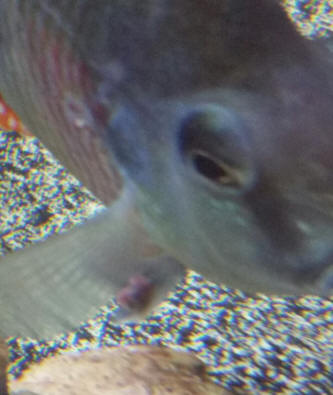 |
|
Re: Intermedius cichlid 8/10/15
As far as numbers go my Ph is 7.8,
<Any idea the hardness? Especially the carbonate hardness, which is involved
with minimising pH changes between water changes. The addition of calcareous
material to the aquarium (tufa rock for example) will raise carbonate hardness,
as will the use of Rift Valley salt mix, which you can make thus:
Per 5 US gallons (20 litres) add the following amounts of each ingredient:
* 1 teaspoon baking soda (sodium bicarbonate)
* 1 tablespoon Epsom salt (magnesium sulfate)
* 1 teaspoon marine salt mix (sodium chloride + trace elements)
Stir well, add to the tank, and you're done. As always, don't make dramatic
changes to water chemistry all at once. Across a serious of water changes,
perhaps 20% per day, would be a good approach.>
ammonia and nitrite 0, nitrate is currently between 10-20 (the color in the test
tube is between those two), and almost always under 20 except in rare cases like
being away on vacation and not being able to do a water change that week, which
might be the issue since I was gone recently for 10 days?
<Possible, and such "oversights" do sometimes trigger problems with cichlids.
But I'm not convinced that we can explain away the problem.>
I did a water change and test as soon as I got home and parameters were almost
identical to what I listed above.
<Good.>
Temp is 78. I run two MarineLand canister c360 filters and two large air stones.
I do have a Carib sea sandy substrate. Most of the tankmates are Aulonocara, I
have three Labs, and one Iodotropheus. Almost all of the aggression is between
the two dominant male peacocks in the tank.
<Predictable! But otherwise sounds fine.>
So I don't know if he was stressed out by water issues or aggression when I was
gone, but the cyst didn't appear until after I was home for a week.
<Hard to say. I'd maybe treat as per Finrot in case there's a bacterial
infection, but otherwise optimise environment and diet, and see what happens.>
Lauren
<Do have a read:
http://www.wetwebmedia.com/lymphfaqs.htm
But also here:
http://www.wetwebmedia.com/virdisnonlymph.htm
http://www.wetwebmedia.com/virdislymphf.htm
http://www.wetwebmedia.com/virdiscures.htm
And also follow the relevant links. Cheers, Neale.>
|
|
White cyst - like bump on cichlids nostril
7/5/14
Dear WWM Crew,
We have been in the fish business for about 1.5 years. The question I
have pertains to our 120 gallon cichlid tank. We have 22 cichlids from
Lakes Victoria, Malawi, and Tanganyika. Some of our fish are 6 inches
all the way down to 1 inch. We check our water every week or 2 and we do
10-20% water change every week. Currently, our water tests perfect in
every category. It has been the same for the last 2 months (prior to
that it was cycling). We just purchased a 6 inch bumblebee
(Pseudotropheus crabro) 2
weeks ago. It has been acting fine and feeding well. All of our other
fish appear themselves and very normal. Three days ago I noticed a white
pimple/cyst on its right nostril. It has grown a bit since then. It is
about twice the size of an O. I am unsure of what to do. I don't like
using medicines, but of course I will if that is what he needs. I have
researched and could not find any descriptions or pictures that matched
our
bumblebees situation. I would really appreciate your advice and I thank
you so much for your time.
Sincerely,
Allison
<Looks like an infected nostril, with a prolapse or similar causing
internal tissue to expand outwards. May clear up in time, but I would
definitely treat with an antibacterial or antibiotic (don't forget to
remove carbon, if used) as per Finrot. The use of Epsom salt at 3
teaspoons per 5 US gallons/20 litres would be beneficial. Have bcc'ed
our resident cichlid expert, Chuck, to see if he can chime in here.
Cheers, Neale.>
|
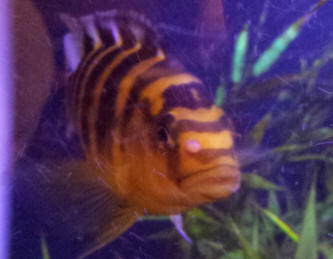 |
|
Re: White cyst - like bump on cichlids nostril
7/5/14
Neale,
Thank you so much for responding! We will get him into our hospital tank
and begin treatments. What medication do you recommend?
<Whatever's sold in your area that's good for Finrot would be a good
first choice. Seachem Kanaplex or the old favourite Maracyn 1 + 2
combination are two options. Basically, avoid the "natural" (read:
unreliable) treatments such as Tea-Tree Oil. On the other hand, using
Epsom salt often helps reducing swelling, and a modest addition of sea
salt can be beneficial to cichlids if they're under the weather a bit,
though don't go nuts, a teaspoon or two per gallon is ample.>
He's a lovely fish and we don't want to lose him. Thank you again.
<Most welcome, Neale.>
Sincerely,
Allison
White cyst - like bump on cichlids nostril
/Chuck's go
7/7/14
White Bumps On Cichlid's Nose
Dear WWM Crew,
We have been in the fish business for about 1.5 years. The question I
have pertains to our 120 gallon cichlid tank. We have 22 cichlids from
Lakes Victoria, Malawi, and Tanganyika. Some
of our fish are 6 inches all the way down to 1
inch. We check our water every week or 2 and we do 10-20%
water change every week. Currently, our water tests perfect in
every category. It has been the same for the
last 2 months (prior to that it was cycling). We just purchased a 6 inch
bumblebee (Pseudotropheus crabro)
2 weeks ago. It has been acting fine and
feeding well. All of our other fish appear
themselves and very normal. Three days ago I noticed a white
pimple/cyst on its right nostril. It has grown a bit since then.
It is
about twice the size of an O. I am unsure of what to do. I don't like
using medicines, but of course I will if that is what he needs. I
have researched and could not find any
descriptions or pictures that matched our bumblebees situation. I would
really appreciate your advice and I thank you
so much for your time. Sincerely, Allison Hicks
< You crabro has an infection in its sinus cavity. Sometimes cichlids
dive into the sand and gravel sifting for food and a small particle of
the substrate gets lodged in the sinus cavity. This particle can
irritate the
lining causing and infection even after the particle becomes dislodged.
The infection seals off the sinus cavity and no circulation comes
through making it difficult to treat. This infection may work its way to
the surface where it can be treated. At one inch it is going to be
difficult to really clean the area. I would recommend placing the fish
in a small hospital tank and treating with a Nitrofuranace (Furan-2)
type of compound. It has any bacterial and anti-fungal
properties.-Chuck>
|
|
African Cichlid Tumor? 10/8/12
Cichlid Tumor Treatment
Hi Crew! I’m hoping you guys can provide some advice or insight regarding a
sick African cichlid- “Bumblebee” (Pseudotropheus crabro) that I have had
for almost 4 years now. He is just over 5 inches in length.
Tank Info- 75-gallon freshwater tank; Marineland Emperor 400 HOB filter; 2
airstones powered by Whisper air pump; Tahitian moon gravel/sand which
replaced pebble gravel over a year ago. Aquasafe water conditioner used
during all water changes.
Tank mates- 1 acei cichlid (approx. 5.5 inches in length) ; 1 electric
yellow (3.5 inches in length); all 3 cichlids bought within 2 weeks of each
other and were at similar sizes at purchase; no other tank mates ever.
Bumblebee has generally been in the middle hierarchy of the tank as the acei
is the most dominant tank inhabitant and the electric yellow as the least
dominant with no major incidents- just the usual territorial/chasing
behaviors exhibited by all 3 over the years. There are also a number of
Anubias plants in this tank that have been in the tank for just over 2
years. The system has been quite stable with no major environmental concerns
outside of a submersible heater that went bad early in 2011 and water temps
dropped for a few days before I noticed.
Water quality is tested at least monthly with 15-25% water changes completed
every 2-3 weeks or more frequently on some occasions. I feed daily Hikari
Cichlid Gold medium floating pellets and Omega One Super Color small sinking
pellets simultaneously to help with aggression during feeding- no changes
over the last couple of years in terms of diet.
In July of 2012 I first noticed 1 then 2 small “pimples” developing on
Bumblebee’s nose between the eyes (see first image). No other concerns noted
at that time- no changes in activity; appetite still great, etc.. Water
quality was tested and was in range of the tank norms (pH 7.6; 0 Ammonia; 0
Nitrites; 5-10ppm Nitrates; 81.5 degrees F). I have always added a low
amount of aquarium salt during water changes (1 tbsp per 10 gallons or half
the recommended dose due to the plants in the tank) but I increased the salt
to the recommended 1 tbsp per 5 gallons at that time hoping that the pimples
were just the result of scratching against décor or an aggressive tank mate.
No changes observed whatsoever with tank mates to date.
Over the past month the 2 pimples have begun to grow quite rapidly with no
other changes noticed in activity except that the bumblebee has been the
least dominant tank mate since mid-August. Appetite has been great/no
changes in activity levels.
Last Monday (10/1) Bumblebee began flashing against the tank decorations
rubbing the large tumor-like growth and removing some of his skin showing
the inner pink ulcer/tumor. I immediately removed him to a 20 gallon
hospital tank with that change in his behavior. Water quality in the
75-gallon tank was fine upon testing (pH 8.0; Negative for ammonia and
nitrites; 5-10 ppm nitrates; 82.2 degrees F)
I have treated him for the past week with API’s T.C. Tetracycline powder- 2
packets per day due to 20 gallon quarantine tank with 25% water changes
every 2 days.. I used that treatment for 6 days with no results (see other 2
images attached).
Bumblebee continues to flash against the corners of the tank and has
debrided some of the ulcer/tumor- there are no décor or substrate in the
hospital tank only a heater, airstone, and AquaClear 50 HOB filter.. I
removed the tetracycline and it’s brownish water discoloration by placing
activated carbon in the tank and have done significant water changes to the
hospital tank.
Many of the FAQ’s on WWM that seem similar to my cichlids issues have
suggested the use of Nitrofuranace and Metronidazole. The products in my
area containing those ingredients that I could find this weekend are the API
products “General Cure” and “Super Ick Cure”. I added today to the clean
hospital tank the “General Cure” for a 20 gallon treatment since the active
ingredients are 250 mg Metronidazole and 75 mg Praziquantel per packet.
I am attaching a couple images to clarify what this looks like because this
seems to perhaps be a tumor issue as opposed to a bacterial, fungal, or
parasitic condition.
The ulcer/tumor is quite large now and looks like it might be spreading just
below his right eye and my other concern is that it might be growing inside
of Bumblebee’s mouth and I can see a slight pink growth near the top of the
mouth (but this is difficult as you can imagine to see definitively). There
do not appear to be any changes in his breathing at this time.
Appetite during and since the completed Tetracycline treatment has been very
minimal but that seems to be the norm with antibiotic use as I understand.
I appreciate your input and perhaps someone has had some experience in this
type of concern- if not I will continue to run the current course of
treatment and if unsuccessful I will enjoy the time remaining with Bumblebee
unless it causes him distress as I’m really concerned about what could be
growing inside of his mouth and how that might impact his quality of life.
Sorry for the length here but I wanted to describe everything I could to aid
in your input- to clarify my questions now are as follows..
1. Any thoughts as to the epidemiology of this growth?
< I have had this same situation before and was lucky enough to have a fish
vet friend of mine do a biopsy and take a look under a microscope. It turned
out to be cancerous tumor.>
2. Should I continue the “General Cure” treatment over the next 4-6 days?
< Probably not effective.>
3. Should I simultaneously use the “Super Ick” powder with the “General
Cure” to combine 3.6mg malachite green and 60 mg Nitrofurazone per packet
along with the Metronidazole?
< I would recommend that you surgically remove it. I have done this before
with mixed results. I would place the fish in a wet towel and hold him
still. Take a single edged razor blade and trim the tumor flush with the
contour of the head. be careful to only cut into the tumor and not into the
head tissue. Treat the wound in a hospital tank with a Nitrofuranace type of
antibiotic. It may grow back. Watch for secondary infections.-Chuck>
Thank you so much for your time in this regard!
Mark King
|
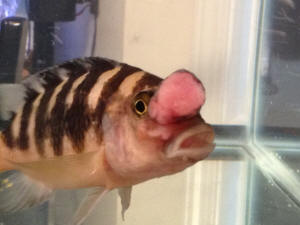
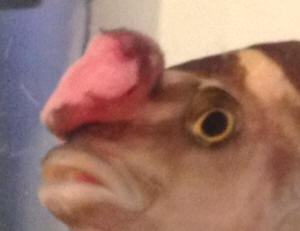 |
|
Sick Malawi cichlid 7/29/10
I would appreciate your help with this one. One of my cichlids
has developed a series of cysts on both sides at the base of her
top fin.
<I see this in your images>
The tissue on both sides is being destroyed and looks like it
will eventually create a hole at this site as it progresses. This
is one of my most colorful fish, so I would like to save it, if
possible. He is eating well and appears to be suffering not at
all from whatever this is. He lives in a 125 gallon tank with
about 40 other cichlids.
<Mmm, of what species mix?>
The water tests fine and there are breeders in the tank, so I
don't think it's the water. I have enclosed pictures of
the fish and close-ups of the growth[s] as clear as possible.
Many thanks for your help. JBH
<I would move this fish to a separate treatment system (use
two nets to catch it), and treat it w/ Nitrofuranace... Can't
tell "what" the specific cause/s might be from photos,
your lack of information on water quality, but this should stop
this from progressing. Bob Fenner>
|
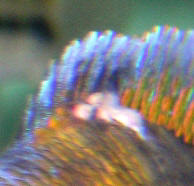
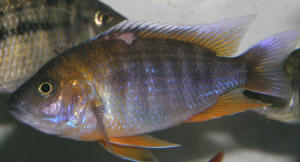 |
|
Re: sick Malawi cichlid 7/29/10
Thank you. Unfortunately, it died.
<Ahh, sorry to read/realize. Sometimes these sorts of
(apparent) injuries become systemic, bacterial et al.
involvements, that can bring about death quite quickly. This and
your other fish appear healthy otherwise. BobF>
|
Hello (Cichlidae; red tube from the anus)
11/13/09
I recently wrote to you about my tank and want to say you have great
advice. I have another question for you..one of my female peacocks has
some type of clear reddish tube coming out one of her reproductive
holes...does this mean she is pregnant or sick??
<Difficult to say without a photo. The spawning tube (or genital
papilla) on female cichlids looks like short, blunt tube with a rounded
tip. It almost looks like a little wart. It's very different from
the equivalent structure on the males, which are longer, usually
angled, and have a pointed tip. Anyway, female cichlids normally show
their genital papillae for very short periods, at most a day either
side of spawning. Males will show there for longer periods, often
several days. If your female is showing her spawning tube, she will
either be spawning or just about to, and she should be obviously
engaged in spawning behaviours of some kind.
Now, a prolapse is very different. This is where a bacterial infection
of the colon causes it to expand and protrude from the anus. This is
very serious, and is a good sign that environmental conditions and/or
diet are very wrong. Treatment with antibiotics, fixing the
environment, and feeding exclusively high fibre foods (e.g., cooked
peas, live daphnia, but nothing dried) can help. The use of Epsom salt
in the water may also help speed up recovery. Chuck outlines the basic
therapy on this page, about half-way down:
http://www.wetwebmedia.com/FWSubWebIndex/texascichfaqs.htm
Finally, there are Camallanus worms. These are red, clearly wriggling
worms protruding from the anus like little red threads. You will need
an anti-helminthic medication to treat them.
http://www.wetwebmedia.com/FWSubWebIndex/nematodesfwf.htm
Cheers, Neale.>
Cyrtocara moorii; damaged lips, infections
7/30/09
Hi,
<Hello,>
I really need help. I purchased some Cichlids from a gentleman that
lives close to me. I bought them because they needed a good home and
this man had just lost his job and such so he obviously needed the
money.
<I see.>
I am really worried however. About two days ago I noticed one of the
blue dolphins had what seemed like a busted lip, but I just figured it
was from a fight.
<Can well be; when fish are moved from one tank to another,
there's often a struggle to reassert dominance. It also depends on
the size of the tank, and a fish used to a bigger tank moved to a
smaller tank may take time readjusting to new boundaries. Yet again,
water chemistry and water quality can be issues; with Malawian
cichlids, clean, hard, basic water is essential, and if moved into a
tank with soft and acidic water, or detectable levels of ammonia and/or
nitrite, opportunistic infections such as Finrot can follow.
http://www.wetwebmedia.com/ca/volume_5/volume_5_2/malawian_cichlids.htm
So there's a bunch of factors. That said, damage to the mouth is
typically from fighting.>
Well it got worse today and now it seems like her bottom lip is rotting
off and her fins are too. They look inflamed and dark red. It looks
like a horrible infection, I hadn't noticed it, and maybe because
it just happened, but another cichlid, that the gentleman called a Big
Spot, has ruined fins also.
<Well, without some details on the tank it's difficult to say
what's going on. At minimum, we need the pH and the nitrite levels
so we can factor out environmental issues. You're aiming for 0
nitrite (as well as 0 ammonia, and nitrate levels no higher than 20
mg/l if possible). Water chemistry should be hard (10+ degrees dH) and
basic (pH 7.5-8). Since Blue Dolphin cichlids (Cyrtocara moorii) are
pretty big, your tank will need to be a generous size, and even a 55
gallon tank is at the low end of what these fish require. They're
also fairly peaceful fish, and more aggressive species, particularly
Mbuna, can cause them serious harm.>
One of my other dolphins has what looks like a "busted lip"
now too!!! I don't know what is going on, but I need to fix it. I
tried researching it on the internet and couldn't find anything
that looked like it. Please help, what do I do? Or are my fish
doomed?
<Doubt they're doomed, but do treat for Finrot (e.g., with
Maracyn, eSHa 2000, etc.) and test, at minimum, the pH and nitrite.
Review tankmates, aquarium space.>
--Thanks
---Anna
<Cheers, Neale.>
| Can you identify this? 4/24/08 Lake
Victorian Cichlid With Growth On Forehead Hi everyone, I really
need help with trying to identify what ailment my fish has and how
to treat it. The fish is a SP44 Lake Victoria Hap. He had developed
what appeared to be some sort of fungus on his lower lip and on his
head. I set up a 10G hospital tank and after making sure he was
acclimated properly and was comfortable in the 10G,I began
treatment with Jungle Fungus Eliminator. His lip cleared somewhat
but the patch on his head would not get better. After a month I did
some research and decided that maybe the problem wasn't fungal
in nature. So after doing a water change, running carbon, and
waiting a couple weeks I began to retreat using Seachem ParaGuard.
The fish has been in the QT tank now for 3 months and although his
lip has completely healed the patch on his head will not go away. I
have stopped treating him last week, and I am not sure what to do
now. He has been active, with good color and has been eating very
well al this time. I noticed tonight the patch seems to be getting
worse, and he is now flashing, rubbing the infected area on rocks
and gravel in the tank so its beginning to really bother him. I
began the ParaGuard treatment again, but I hope you can help me
with diagnosis and a proper course of treatment. Attached are a few
pics. I do not want to lose him. Thanks for your time Eric <
After reviewing your photos I think that you male hap has scar
tissue from either fights or from foraging in very coarse
substrate. As he forages through the sand the abrasive edges scrape
up his mouth and face. This trauma to the face opens up wounds that
can get infected. These start out as a bacterial infections. Things
like fungus feed of the dead and sloughing tissues. These diseases
can be treated using antibiotics like Furanace but they will
comeback as long as the abrasive materials are still in the tank. I
would consider changing the substrate in the main tank. Another
possibility is fights with other cichlids. Cichlids are very
aggressive and if your Victorian hap is sharing an aquarium with a
lake Malawi Mbuna, then the teeth on the Mbuna can cause lots of
damage on the opposing fish. Try the Furanace while he is in the QT
tank and keep up on the water quality.-Chuck> |
|
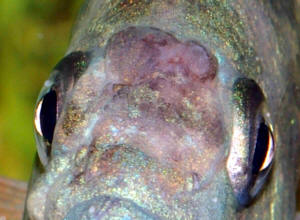

Great pix! RMF.
|
Treating Electric Blue Cichlid for
Bloat - 05/10/2006 Thank you for the response. Now I would
like to know if what I am feeding them is sufficient based on your
response that it may be related to diet. I feed Spectrum large fish
formula and AquaDine. I feed lightly twice daily and
alternate. Once in a while I give them bloodworms only as a
treat (once every 2 weeks). I have a 54 corner with
Juruparis (2) and was told to feed them the bloodworms once in a while,
that's why I have them. <The Spectrum is fine for all fish and I
have never had a problem with it. The AquaDine I believe is sold in
bulk at fish stores and in general I feel that the food loses its
vitamins when exposed to the air. Bloodworms are very meaty and usually
cause problems for Lake Malawi rock cichlids referred to as Mbuna and
Tropheus from Lake Tanganyika. They are probably fine for South
American cichlids like Eartheaters. I would not recommend the
bloodworms for the rift lake cichlids.> I am picking up the
Metronidazole tonight, should I remove the carbon? < Yes.> Also
should I put the meds with some blood worms and feed them to the fish
right away? I have read on your sight to do that in some cases. Thanks
again for your assistance and education in this matter. < If the
fish are still eating I would mix the Metronidazole in a few teaspoons
of water until it is all dissolved. Then pour it over some Spectrum
pellets. Give it a few minutes to absorb the liquid then feed the
fish.-Chuck>
Treating Electric
Blue Cichlid for Bloat - II - Electric
Blue Did Not Make It 5/25/06 Hi Chuck, Thanks for
working with me on this matter. After much treatment and
care the Hap has passed away. Its odd how attached one can become to a
fish. I just wanted to say thanks and it sure is great to have a
resource like yours available to help this hobby thrive. Thank you
again! Michael Bukosky <Thanks for your kind
words.-Chuck>
Re: Bloated Malawi
Cichlids 5/14/06 Thanks again for the response. I
am now back from my trip and the Hap is still gasping for
air. It has been 4 days and no luck getting him to eat.
Before I left on Tuesday I picked up some PraziPro and a tiny amount of
Metronidazole. I went to 3 different fish store and called 2
and no one sells it here. The LFS I primarily use said that
they are no longer able to sell the powder form of it and only sell
some gel tabs that have PraziPro and Metronidazole in
it. They said it has something to do with a Wisconsin
prescription law and human use of it. They gave me a small amount of
their Metro to soak some food in and said to try PraziPro to treat the
whole tank. I used 1 teaspoon per 20 gallons before I left
and retreated last night. On Tuesday and today I soaked some
pellets and feed the fish without him eating and even tried a small
amount of Blackworms to see if that would spark some interest in him
eating and it did not. The Hap Ali looks just fine and is swimming
around but he is gasping for air and when fed he swims to the corner
away from the food but then comes towards it as if he wants to eat but
does not. Any advice as to what else to do? Is this PraziPro a good
alternative to Metro? Thank you in advance for your help with this!
< Im afraid no medication will help at this point. The store was
correct in trying to get you fish to eat the food with the
Metronidazole, but I knew it was not going to eat. The PraziPro is for
internal worms and fluke and these are actually pretty rare in Malawi
fish. You could try Clout in a hospital take or a double dose of
Nitrofurazone too. All the medications I recommend are available online
at DrsFosterSmith.com.-Chuck>
Sick cichlid I have 5 African cichlids and 1 of them is an
electric yellow. The electric yellow has had some sores appear on him
over the course of two months. These sores start with a red spot that
turns into a red ring. Then the flesh starts to be eaten away within
the red ring. After, it clears it leaves an indention on his body. I
went to the fish store and explained what was wrong and they said it
was a bacteria that will only affect electric yellows. <All the
looking that I've done has yielded no fruit as to any illness that
is specific to electric yellows. It sounds to me like
septicemia; I would isolate the fish in a quarantine tank and treat
with Kanamycin sulfate (can be found as "Kanacyn" by
Aquatronics); I have used this before with exceptional results on
goldfish with septicemia.> They gave me neomycin that seemed to work
at first but the sores keep coming back. <Possibly recurring from
water quality issues - neomycin will wipe out your biological
filtration, causing the tank to cycle again. Do please be
testing your water for ammonia, nitrite, and nitrate daily with such
meds, and do water changes to fix problems.> Can you please help me,
he seems to be getting worse! <As above - I think this is septicemia
from the description, but it is altogether possible that there is some
sort of 'electric yellow' disease out there that I don't
know about and can't find info on. Even still, if the
neomycin is supposed to work for it, I would tend to believe that
Kanamycin would, too; I prefer the Kanamycin as it does not mess with
the biological filtration much, and yet seems to be highly effective
against bacterial fish illnesses. Wishing your fish a smooth
recovery, -Sabrina.> Thank you, Karalea
|
Furunculosis on Maylandia estherae?
Hello once again wet friends, No good news this time. One
of my red zebras got sick and could only last one week.
Attached are some photos showing her wound. < This is
actually not a wound but a Pseudomonas bacterial
infection. This is usually caused by the poor water
quality and the fish becoming stressed. The first thing I
would do is clean the filters and do a water change of 30%
with treated tap water. Use a gravel vacuum on the gravel
to remove any detritus build up in the gravel. Check you
ammonia and nitrate levels in your water. The bacteria
actually feed off these while they are eating away at your
fish. Your medication may have killed off the good bacteria
in your filter system so watch out for ammonia , nitrite
and nitrate spikes. Don't feed the tank for a week and
let the fish clean out their guts. If they are hungry they
can graze on the algae off the rocks like they do in
nature.> First I noticed that she wasn't
eating, next day she had a small nasty wound on her side. I
thought it could have been caused by some fighting (four
more females and a male in the same tank plus a little acei
which is doing very well for now). I separated her into a
fry net to prevent any bites on her wound and treated the
whole tank with Sera's Baktapur and Mycopur hoping to
stop any bacterial or fungus infections. In about four days
the wound got incredibly big. On her last day she was at
the bottom of the net, trying to breath. She looked
hopeless and in pain. I had to put her in the cold, dark
freezer. A very lonely death for any creature I believe,
and I don't feel very good about all that
had happened. How could all that happen in just a week?
What did I overlook? Anyway if you can have any
idea by looking at the photos please let me know. It
isn't very noticeable on the photos, the wound is open
all the way to her spine, and one of her ribs were on the
open. Looked incredible. As if she was eaten alive, or
thorn apart. Another bad news is that after about 10 days
of her death I see another one not eating. < You may
also have a case of Malawi Bloat> She actually looked
like she was having difficulty emptying her
bowels. She produced one piece of bubble like faeces. I
have no idea what's going on and this makes me mad.
What is it? What should I do? < Do all of the above. At
the end of the week your fish should be very hungry and
have their faces pressed against the front of the glass. If
not they are probably infected and should be removed to
another tank to be treated with Metronidazole( Hard to get
with poor results). Tropheus from lake Tanganyika also come
down with this problem I would recommend you go to JDTropheus.com and read
his solutions to this problem. I would not recommend
treating the entire tank.> Can I prevent it? < In the
wild your Mbuna come from Lake Malawi. The lake has a pH
close to 8 and is very hard with lots of minerals. The
water temperature is around 77 degrees. These fish usually
eat algae off the rocks and require large amounts of
vegetable matter in their diet. Worms tend to rot in their
gut and give them problems. I would recommend a high
quality vegetable flake and feed them small amounts a
couple times a day. Keep up on your tank maintenance and
your fish should bounce back. Bloat is very difficult to
cure but very easy to prevent.> I also realized I have
some tiny little bugs in the tank. With the naked eye, they
are oval shaped and move around on the surface. I just
happened to notice their existence while I was examining
the dead little one. I don't believe they are connected
with her death. < These are springtails and feed off the
bits of fish food in the water. They are harmless and pose
no threat to your tank or fish. -Chuck> Any help is
highly appreciated. It always feels very good to know
that you people exist, especially on the dark days. Thanks
a lot, Husnu
 |
 |
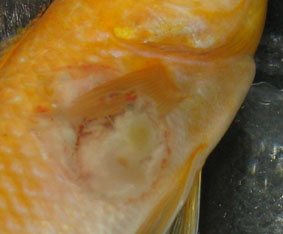 |
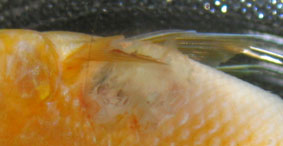 |
| Re: Furunculosis on Maylandia estherae? Hello once
again wet friends, No good news this time. One of my red zebras
got sick and could only last one week. Attached are some photos
showing her wound. First I noticed that she wasn't eating,
next day she had a small nasty wound on her side. I thought it
could have been caused by some fighting (four more females and a
male in the same tank plus a little acei which is doing very well
for now). I separated her into a fry net to prevent any bites on
her wound and treated the whole tank with Sera's Baktapur and
Mycopur hoping to stop any bacterial or fungus infections. In
about four days the wound got incredibly big. On her last day she
was at the bottom of the net, trying to breath. She looked
hopeless and in pain. I had to put her in the cold, dark freezer.
A very lonely death for any creature I believe, and
I don't feel very good about all that had
happened. How could all that happen in just a week? What did I
overlook? Anyway if you can have any idea by looking
at the photos please let me know. It isn't very noticeable on
the photos, the wound is open all the way to her spine, and one
of her ribs were on the open. Looked incredible. As if she was
eaten alive, or thorn apart. <The bacteria that were eating at
your fish were being fed by an excessive nitrate load in your
aquarium. Get a nitrate test kit and check the nitrates. I have a
hunch they will be off the scale. Reduce the nitrate levels by
doing water changes and servicing the filter. The nitrate levels
should be under 25 ppm. When you have the levels down I would
suggest you add some cichlid salt too increase the slime on the
fish. Vacuum the gravel too. This will remove much of the waste
that is adding to your nitrate problem. If your fish don't
improve it may be too late to help them. Sick fish should be
moved to a special tank and treated. Many medications kill the
beneficial bacteria in the filters and the gravel that keep the
nitrogen chain moving along.> Another bad news is that after
about 10 days of her death I see another one not eating. She
actually looked like she was having
difficulty emptying her bowels. She produced one piece
of bubble like faeces. I have no idea what's going on and
this makes me mad. What is it? < Malawi Bloat> What
should I do? < Remove the fish to a special isolated tank and
try to treat it with a medicated food with Metronidazole in it.
If is not eating you could try a furnace type medication and slat
but the chances of recovery are slime> Can I prevent it?
<Absolutely! Check the nitrates in your tank often and try to
keep them under 25 ppm. A test kit will help you determine when
to do your water changes and how much water you need to change.
Mbuna (Malawian Rock Cichlids) eat algae off the rocks in the
wild. I would start feeding a high quality Spirulina flake food.
Their health and color will greatly improve. Stay away from foods
like worms. They are not required by these fish. Some people will
tell you that they feed their fish all kinds of worms and have
had no problems. They may just be lucky. In the long run you are
better off with the flakes.> I also realized I have some tiny
little bugs in the tank. With the naked eye, they are oval shaped
and move around on the surface. I just happened to notice their
existence while I was examining the dead little one. I don't
believe they are connected with her death. < These are little
springtails and are totally harmless to the fish. I think they
come in as contaminants from the fish foods. -Chuck> Any help
is highly appreciated. It always feels very good to know that you
people exist, especially on the dark days. Thanks a lot,
Husnu |
|
Sick Cichlid? Hello, I am writing with hopes of a
solution. <And I hope this reaches you well, please forgive
the delay.> I have a Copadichromis trewavasae which is wild
caught. It has developed two wart like growths. One is just below
its mouth and one is right by its eye. They are growing fairly
quickly. I am a long time hobbyist and work in the field but I do
not know what this is or how to treat it. <Although this could
describe very many diseases, the first things that pop into mind
are Lymphocystis, Columnaris, perhaps a fluke or helminth under
the skin, or possibly even an indicator of
mycobacteriosis. It might be a help to know how long
the fish has been in captivity, and how long in your care.> I
tried Rid Ich thinking a parasite but it was ineffective.
<Were there any improvements/changes at all during that
treatment? Did it get worse during that time?> I
say wart like because of the shape, the way it protrudes and it
is the same color as the fish tissue. <If the fish is
pale/scared, do the lumps still remain the same color as the
fish, or do they seem a bit dark or grayish? Have they
developed any "cottony" looking tufts? The
location of them (eye, mouth) seems consistent with the very
beginnings of Columnaris, which can look like a slightly
off-color lump in its early stages, but again, there are so many
things this might be.... At this point, if there's
no hint of the cottony tufts of Columnaris, I'm pretty sure
you can rule that out. Lymphocystis would develop into
whitish cauliflower-looking lumps, so if that hasn't happened
yet, I think you could rule that out, too. If the
lumps have developed into raised lesions, I think it would be an
indicator of mycobacteriosis. There is always the
possibility that these are small tumors, as well, in which case
there really is nothing you can do. If the fish is
only recently in captivity, I think there is a very strong
possibility of this being a fluke or helminth encysted under the
skin; if the fish is not badly infested, you might just wait it
out, or try treating with food containing Levamisole or
Piperazine - really, I think it is likeliest that this is what
you're dealing with. Again, some history on the
fish might help a bit.> Any insight would be appreciated.
Thanks for your time. <Sure thing - and again, sorry for the
delay. I hope all goes well for you and your
fish, -Sabrina> John
|
|

